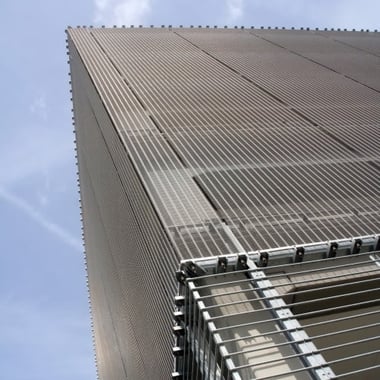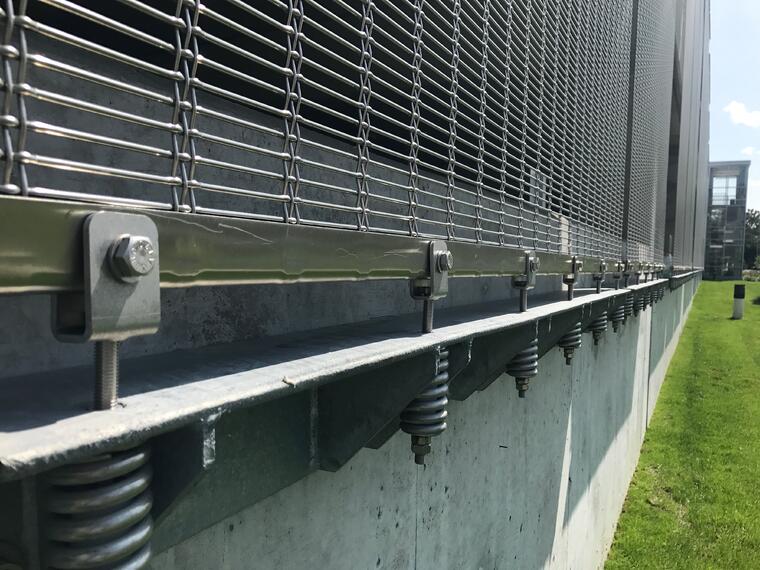Understanding Architectural Mesh: Structural Calculations
Architectural Mesh - Exterior | Architectural Mesh - Interior
Properly installed stainless steel woven wire mesh is a beautiful, functional, and long-lasting option to cover a building facade. One of the significant benefits of this material is its ability to span over a hundred feet vertically in a single, visually homogeneous panel.
And so, unlike smaller panelized facade solutions, each mesh panel installed only requires substantial substructure for the connections at the top and the bottom of each element. This can translate into substantial time and material savings over visually comparable panelized systems.
W.S. Tyler has been a prominent architectural mesh manufacturer for over 20 years, helping architects and contractors achieve the appropriate tensioning needed for your mesh panels to deliver awe-inspiring aesthetics for years to come.
And with that, we will be covering everything you need to know about the structural calculations you need to ensure a proper install, including:
- What a structural calculation is
- What information a structural calculation report provides
- How you apply the calculations from a structural calculation report
- How much a structural calculator report cost
What Is a Structural Calculation?
Whether for new construction or a retrofit application, the Structural Engineer of Record (EOR) on the project must determine the appropriate substructure forms for the mesh connections.

To assist with this work, W.S. Tyler provides a Structural Calculations Report, which is developed for each individual job based upon project-specific information. This report takes into account all of the relevant material details and environmental variables, such as:
- Mesh specification (pattern, density, and wire sizes)
- Panel dimensions (widths, heights, and cutouts)
- Maximum unsupported vertical spans with no intermediate connections
- All hardware supplied for attachment (springs, bolts, nuts, etc.)
- Locations of panels on the facade (center positions vs. corner elements; ground floor vs. roofline)
- Applicable Building Codes local to the project (wind loads, snow and ice loads, recorded temperature deltas, etc.)
What Information Does a Structural Calculations Report Provide?
The Structural Calculations Report is all-inclusive and typically consists of 15 to 20 pages. The report lists every condition, assumption, and proof that is taken into consideration for a particular project, along with the calculated results.
The real product of this work - the primary detail that an Engineer typically looks for - is the consequent worst-case overall vertical load.
When a mesh panel is installed according to the supplied W.S. Tyler Shop Drawings, the springs will have been uniformly compressed to a listed specific dimension. This defines the proper pre-tension condition for that particular mesh panel.
The resulting vertical loads will be a little over 400lbs per linear foot across the substructure elements. We refer to this as the “static load”, and it is fairly consistent from job to job.
Once a mesh panel installation is complete, and all of the intermediate connections have been established, the element is ready to withstand the local environmental forces. The mesh and the spring attachment system are inherently flexible.
This means that the resulting “dynamic load” can vary tremendously from site to site, due in part to the local weather conditions, the geometry of the facade, and the mesh pattern selected, just to name a few variables. The resulting anticipated worst-case “dynamic load” can be two- or three- or more times higher than the “static load” on the installation.
What Do I Do With These Calculations?
Given all of this information and considering the structural condition of the building itself, the SOR is used to specify the substructures that are appropriate for the job. We often see hot-dipped galvanized angles used for this application; they are structurally appropriate, readily available, and relatively affordable.
In fact, when we are consulted in the early stages of design, we usually recommend the following structural placeholder: 6” x 6” x ½” hot-dipped galvanized angles for the top and bottom connections, and similarly 3” x 3” x ¼” angles for connection of our intermediate tubes.
How Much Does a Structural Calculation Report Cost?
A project-specific Structural Calculations Report is a critical part of any offset facade installation. Because we believe that this is so important, a W.S. Tyler Structural Calculations Report is included in the contract price for every tensioned mesh facade job that we execute.
Further, we understand that as the work evolves, the calculation information may be affected; we will keep an eye out for this, and an updated report will be provided at no additional charge where necessary.
Find a Mounting Solution Suitable for Your Substructure
A Structural Calculations Report is generated and used to help your structural engineer implement adequate substructural support when installing architectural wire mesh panels. To ensure your mesh stands the test of time, the report is drafted assuming the mesh is constantly subjected to the worst-case scenario.
So, you now know what to expect when you receive a structural calculation report. To better understand why they are so important, you must get to know the different mounting solutions audible and how the substructure plays an integral role in their performance.
Here at W.S. Tyler, we believe it's our responsibility to educate architects, contractors, and everyone in between about each step needed to get the unique aesthetics of architectural mesh incorporated into the architectural design process.
For more information regarding how architectural mounting, read the article:




